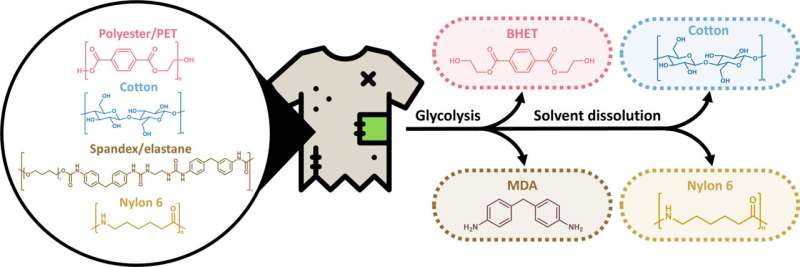July 5, 2024 report
This article has been reviewed according to Science X's editorial process and policies. Editors have highlighted the following attributes while ensuring the content's credibility:
fact-checked
peer-reviewed publication
trusted source
proofread
New chemical process separates textile fibers for easier recycling

A combined team of chemical and biomolecular engineers from the University of Delaware, and the Center for Plastics Innovation, both in the U.S., has developed a way to chemically separate fibers in textiles, allowing them to be recycled more quickly and cheaply than conventional methods.
In their paper published in the journal Science Advances, the group describes the process they developed and how well it worked during testing.
Over the past several decades, the evolution of textile production for use in producing clothes has led to what the research team describes as "fast fashion"—where clothes that are considered fashionable by consumers are purchased and worn for a short period of time before being discarded as new fashions appear.
Such clothes have also evolved in a way that has led to the use of multiple types or blends of fibers, which makes recycling them difficult. In this new study, the research team has found a way to chemically separate such fibers so that they can be easily and inexpensively recycled.
The process developed by the team involves using a solvent to break the bonds that hold polyester together with other materials such as nylon or cotton. The researchers found they could speed up the bond-breaking by adding zinc oxide as a catalyst and tossing the clothes in a microwave oven.
Using such an approach, they found they could break apart the textiles in as little as 15 minutes. They also noted that the process releases nylons, cottons, and other materials while also breaking down the polyester into BHET (and spandex into monomers), which they note, is an organic compound that could conceivably be used to create more polyester.
In testing their process, on polyester/cotton and spandex/nylon blends, they found that the material integrity of both the nylon and the cotton were retained, suggesting they could be used to make new batches of clothes. They also noted that flame retardant chemicals used to treat clothes interfered with the process, thus a means for their removal would be needed prior to recycling.
The researchers concluded their study by offering math models to show that their process could be an economically viable way to recycle textiles.
More information: Erha Andini et al, Chemical recycling of mixed textile waste, Science Advances (2024). DOI: 10.1126/sciadv.ado6827
Journal information: Science Advances
© 2024 Science X Network




















